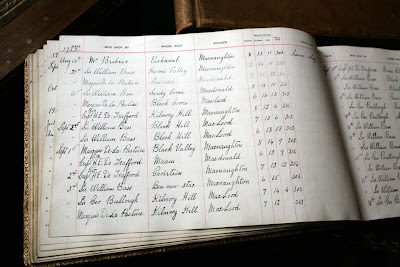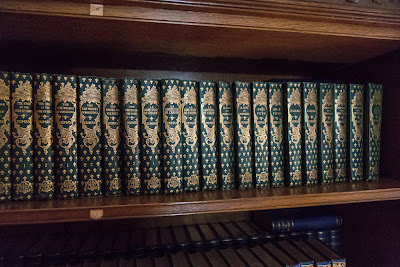Our home for the night had been the Edwardian pile of Kinloch Castle. It was built between 1897 and 1900...
...by Sir George Bullough who spent his father's fortune on it. The red sandstone was imported from Annan in Dumfriesshire and 500,000 tons of topsoil from Ayrshire were imported for the castle's Japanese garden and golf course. It cost about 0£15 million at today's prices.
We took breakfast in the servants' dining room. Abby cooked an amazing "Full Scottish" breakfast that contained more than enough calories to propel us over the Sea of the Hebrides to our next destination, the island of Eigg. Speaking of Eigg, we met Alastair from Eigg over fried eggs and we were delighted to hear that his wife Sue would be happy to open her B&B Lageorna for us that night.
Abby now kindly took Ian and I on a conducted tour of the castle. We made our way down the servants' corridor past this old coin operated phone with "press button A then press button B" technology.
We mow entered the main wing of the castle. The corridor was adorned by antlers and...
...tarpon which Sir George had caught from his steam yacht Rhouma.
The galleried hall.
In fact the whole castle is stuffed with things that once rutted, crawled, swam,...
...flew...
...or roared.
Kinloch Castle's shooting books record days of hunting. On September the third 1925, Sir George Bullough killed a 7 point stag weighing 14 stone and 4 lbs on Kilmory hill with a 0.303 inch rifle. He was assisted by his stalker MacLeod.
Another of Sir George's prizes was his wife Lady Monica or Monique Lily de la Pasture. Depending who you believe, Sir George may or may not have also liked the company of men
Whatever, Lady Monica liked to while away the hours drinking tea while sitting butt naked on the lion skin in the great hall. The painting is known as either "Nude on a skin" or "Lady drinking tea". It is by Louis Galliac.
The island of Rum is a rum old place. Most people associate it with the sea eagle but there are other eagles to be found on the island. On one of his trips on his yacht, SY Rhouma, George Bullough visited Japan and became friends with the Emperor. Sir George bought this bronze monkey eating eagle...
...with two matching incense burners, each topped by lesser eagles. He packed them away in a nook somewhere on Rhouma and brought them back to Kinloch Castle as souvenirs of his Far Eastern travels.
This snug fireplace is in one corner of the great hall and just in case you were wondering...
...yes the piano is a Steinway.
The hall also has a fine gallery which we will come back to in a moment.
The Sy Rhouma's bell sits on the hall table and round the...
The Dining Room.
...dining table, her.......chairs grace the dining room. The chairs swivel so that diners may more easily leave the table.
.
The lower dining room walls feature fine mahogany panelling while the upper walls are hung with...
...rather romanticised paintings of Rum by Byron Cooper and...
...this appreciation from the Corporation of the City of Capetown for Sir George's loan of his steam yacht Rhouma for a year during the Boer War as a hospital ship.
This photo shows the SY Rhouma's main cabin, which was the dining room, converted to a ward for invalided soldiers.
The SY Rhouma was originally named the Maria.She was built by Napier Shanks & Bell at Yoker on the Clyde as a steam yacht of 250'2" overall and was launched on 6/6/1893. She went on to be commissioned by the Italian Navy in 1912 when she was renamed Giuliana. Under Sir George she had space for a 12 man orchestra.
In 1913 Sir George replaced SY Rhouma with another Clyde built steam yacht the SY Triton, which he renamed SY Rhouma. This vessel was built at Ailsa Shipbuilding Company in Troon on the Clyde This was the very same yard that in 2000 built the MV Loch Nevis, the current ferry that serves Rum and the other Small Isles. Sadly the MV Loch Nevis was the last ship built at the Ailsa yard as it closed in 2000. The SY Rhouma was sold in 1920 but amazingly she is still afloat. In 1975 her steam engines were removed and replaced with diesel engines. Her current name is MY Madiz..
The billiard room.
The billiard room was fitted with airconditioning and like the rest of the castle double glazing and electricity from a hydroelectric scheme.The castle was fitted with an early phone system that linked the various rooms.
Sir George bred dogs and horses...
...he also liked to think he had good breeding and had his pedigree on the wall to prove it.
Under the stairs.
This amazing machine was also powered by electricity.It is an Orchestrion one of only three ever built by...
...Imhof & Mukle. This one was built for Queen Victoria but she died before it was delivered. Sir George bought it in 1906 for £2000.
It came with a great variety of tunes on paper rolls.
Lady Monica's Drawing room.
Lady Monica's Drawing room is situated on a sunny corner of the castle and is light and airy compared with the dark manly panelling favoured by Sir George.Sadly the hand embroidered silk wall covering has seen better days.
This elegant clock has...
...nothing as irrelevant as a minute hand.
This alabaster diorama depicts Persephone sitting on on her throne. Her husband, Pluto, carries the recently deceased Eurydice on his chariot drawn by by two stallions. They are passing the three headed dog that guards the entrance to the Underworld.
The lower corridor.
This stained glass window's shelf was adorned by some beautiful Japanese vases.
The Empire Room.
Lady Monica claimed descent from one of Napoleon's sisters and the Emperor was used as the theme for the decoration of her boudoir and private retreat.In a corner is a case of humming birds these flew in a heated palm house but the heating failed and they all died and so Lady Monica had them preserved. It just goes to show that it was not just Sir George that liked to stuff things.
The ball room.
The ball room has an oak sprung floor and...a beautiful chandelier.
The stained glass windows were high on the wall so no one could look in. The musicians from the Rhouma played in a minstrels gallery behind a high balustrade so they could not see into the room. A double hatch from the butler's pantry allowed a supply of drinks in but with no servant to see the assembled guests. The mind boggles.
The dentist's surgery.
No castle is complete without a dentist's chair... "Is it safe...?"
The library.
The library gives the appearance of being well stocked and......indeed there are some interesting journals of Sir George's voyages in the Rhouma but...
...the rest is a bit of a sham. The shelves are padded out by multiple copies of each book. "I say, I would like some books for the library." "Certainly sir, how many would you like?"
Sir George's Bedroom
Sir George's boots still sit by his bedroom's fireplace. Judging by their size, he was a big man......who liked to keep in trim...
...in some of his own tartan plaid.
Lady Monica's Bedroom.
Lady Monica's bedroom has a pleasant sunny aspect with a view of Loch Scresort.It is a much softer room than Sir George's and has an...
...en-suite bathroom with the most amazing shower bath that has...
...jets that come at you from all angles. Very refreshing.
Like the shower the WC is by Shanks of Barrhead.
The Hall Gallery.
The hall gallery gives a splendid view of the bric-a-brac and gee-gaws contained in this remarkable room.
Also on the balcony are two further paintings by Byron Cooper. This depicts the Skye Cuillin from Kilmory and...
...this is the Rum Cuillin.
Finally this is a magnificent Japanese lacquered cabinet which stands next to Sir George's portrait.
The tower.
This bronze was both a weather vane and a lightening conductor.
The Cuillin of Rum were concealed by dark clouds.
The turret even had old Secomak electric air raid siren perhaps dating from 1914, when the dark clouds of war blew over Kinloch castle and swept its Edwardian excesses away.
What a tour of Kinloch Castle we had! It is an incredible time capsule of Edwardian extravagance and opulence. The outbreak of WW1 in 1914 brought the heyday of Kinloch Castle to a close. Sir George died in 1939 and is buried in the family mausoleum at Harris in the west of the island. Lady Monica continued to visit Kinloch Castle at infrequent intervals. On one her last visits in 1954, aged 85 years, she drove herself over the rough 4x4 track to Harris to visit Sir George's tomb for one last time. Lady Monica, died in 1967 at 98 years of age and was also laid to rest in the Mausoleum. The family trustees then sold Rum and the Castle to the Nature Conservancy Council for £23,000. High in the hills above the Mausoleum there is a small loch. It is called Loch Monica.




















































































